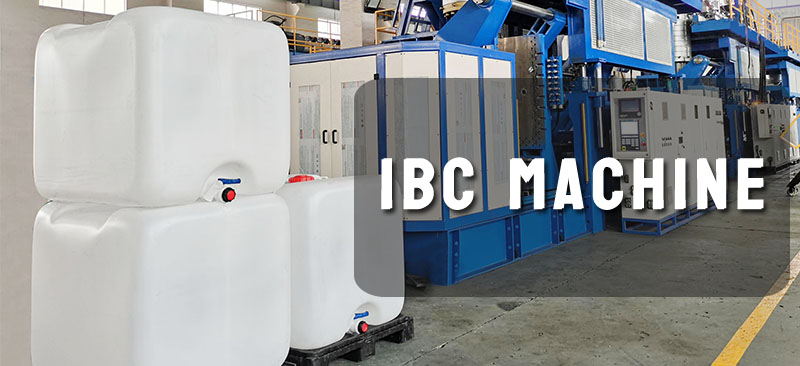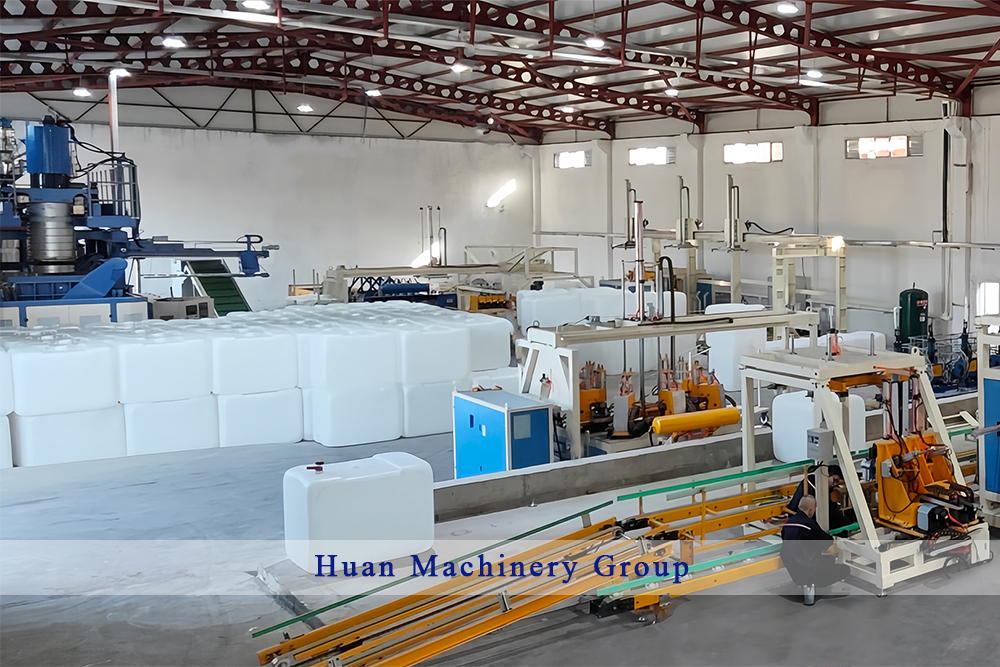
IBC, also known as IBC intermediate bulk container, is a package container used for stocking and transporting liquid products. The IBC is composed of an inner tank and cage, bottom pallet. The inner tank is by an extrusion blow molding machine from HDPE material.
IBC was designed by a German company. Ten years ago, China began to import European IBC machines for blow molding production. At present, Chinese IBC demand reaches one-third of the world's total usage. Because other packages such as jerry cans, and 200L and 220L drums cannot be transported by forklifts, the designer hopes to produce a cyclable packaging that can be easily transported by forklifts, so the IBC was born.
The IBC originally with round tube and outer cage, HDPE inner tank. After continuous evolution, it was composed of a square tube and an inner tank with vertical ribs. There are also bottom pallets of different materials, including steel bottom pallets and wooden bottom pallets. There are plastic bottom pallets and sometimes that combine plastic and steel material.
IBC is composed of HDPE plastic material, galvanized steel pipe, galvanized stamping parts, plastic cover, and plastic valve. HDPE needs to have special performance, melting flow rate, density, etc., which is different from the normal HDPE character. Now some suppliers produce the IBC grade HDPE worldwide.

The steel material needs to be galvanized on the surface, and the weight of the zinc should be more than 80 grams to be rust-proof. The thickness of the steel pipe should be more than 1.0 mm, and the thickness of the base plate should reach 2.0 mm. The valve is one of the important components of IBC, A valve consists of 14 parts, and the valve type includes ball valve, butterfly valve, welding valve, screwed valve, etc. The sealing ring of the valve cover also consists of 3 to 4 different raw materials, according to the corrosion performance of the liquid inside.
With the continuous updating of production technology, the current production of IBC products consists of the following four parts: IBC inner tank, IBC cage, IBC bottom pallet, and IBC assembly line.
Our IBC tank blow molding equipment: adopting advanced German extrusion technology, it can currently produce 1-layer, 2-layer, and 3-layer liners. The package is tight, the thickness is uniform, and the production is stable. Output reaches 600 IBCs per day, and the valve neck size is accurate with zero leakage.
IBC cage production machine: 21pcs steel pipes are welded by electric strode and welding. This technology is at the top level in China. The welded steel grid can reach a torque of more than 120N, which is very strong. The precision of the frame locking is very high without any unqualified chance and output can reach 50 cages.
Our IBC machine produces IBC that strictly follow the world's IBC classification society and UN standards, with drop tests, stacking tests, hydraulic tests, and vibration tests. During all, the drop test is conducted at a temperature of -18 degrees Celsius with a height of 1.9 meters, no breaking; the stacking test is with a pressure of 4.5 tons for 10 minutes, and the bottom IBC remains un-broken; the vibration test also has perfect results without damage after vibrating for 1 day; the hydraulic test involves bearing pressure of 100Kpa for 10 hours, and both the inner tank and the out cage remains unbroken. Of course, we constantly measure the thickness of the IBC HDPE tank during the production of the IBC tank blowing to make sure that the IBC tank thickness is between 1.5mm and 2.2mm.
IBCs are widely adopted in the package of chemical liquids, mainly including phosphoric acid, sulfuric acid, hydrogen peroxide, coatings, lithium electrolyte, glue, etc. Valves with different sealings are optional according to the corrosiveness of the liquid, Meanwhile, the layers of the IBC tank may also change, with two or three layers, and the inner layer with virgin HDPE. IBCs are also widely adopted in the food and beverage industry, such as concentrated juice, which requires cleanliness of the inner layer. Of course, IBC is also widely used in many other fields, including various lipids, pesticides, etc., now replace many 220L drum and 25L stack jerrycan packaging functions.
The reason why IBCs are so popular is that they have unique advantages that other plastic packaging products do not have:
Square shape, very convenient for stacking and storage. Compared to a 220L double L-ring chemical drum, 1000L IBC can save one-third of the storage space.
Due to the tray-shaped base support, it is convenient for forklifts to enter in and out, transport, and stack, making it very convenient for warehouse handling and loading and unloading of containers.
At the same time, there are various pressed shapes suitable for forklift entry and exit at the bottom, fitting various concave and convex shapes of the tray, etc. Depending on the nature of the liquid load, different types of valves are optional: screw-tightening valves and welding valves. These two types of valve connections have advantages and disadvantages. The threaded screw-tightening valve is convenient for replacement, and the welding valve has no leakage risk. Different types of valves are optional based on the liquid leakage hazard coefficient.
HDPE can be recycled and reused, and the middle layer of IBC can also be adapted with PCR HDPE material. The deflashing edge material of the HDPE tank can be crushed after cooling for half an hour and then mixed with virgin HDPE in a certain proportion before fixing into the IBC blow molding machine for recycling.
The application of IBC greatly facilitates transportation and saves transportation labor costs. It also saves storage space and reduces factory and warehouse costs. In addition, it simplifies the complex procedures during the filling process, saving labor costs in the filling section, which is beneficial to cost savings in various links of packaging and logistics.
With the upgrading of technology and the progress, the cost of IBC needs to be continuously reduced, and the performance of the products needs to be continuously improved. Therefore, new requirements depend on IBC machines. Currently, the weight of the IBC tank needs to be reduced to save the cost of HDPE, but the performance of the IBC tank cannot be compromised. It needs to maintain the strength and quality that pass through various tests. We continue to optimize our IBC blow molding machines in the extrusion system and design the internal structure of the diehead to meet market demand. At the same time, we have begun to adopt EX anti-static material and PCR recycled material for our IBC tank to meet the requirements for the storage of dangerous goods and to comply with the global request for the reuse of recyclable plastic material.
All those demands finally reflect towards IBC machines. Therefore, we have to update our technology to design corresponding IBC machines that meet the market's new requirements for IBC tanks and cages.













